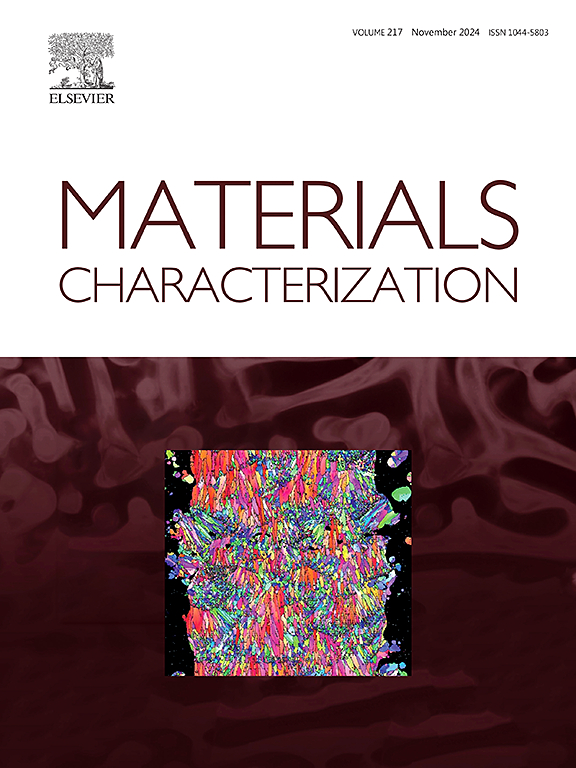Optimization method and mechanism of microstructure and properties of WAAM AlCu alloy reinforced with two-dimensional h-BN particles
IF 4.8
2区 材料科学
Q1 MATERIALS SCIENCE, CHARACTERIZATION & TESTING
引用次数: 0
Abstract
The mechanical properties of Al![]() Cu alloys produced through wire arc additive manufacturing (WAAM) often suffer from degradation due to continuous coarse precipitate phases and uneven microstructure. This research investigated the incorporation of h-BN particles into the deposition process of Al
Cu alloys produced through wire arc additive manufacturing (WAAM) often suffer from degradation due to continuous coarse precipitate phases and uneven microstructure. This research investigated the incorporation of h-BN particles into the deposition process of Al![]() Cu alloys during WAAM, examining how these h-BN particles influence the microstructure and overall properties of the material. The results indicate that h-BN particles promoted grain refinement, leading to a uniform equiaxed grain microstructure and addressing the issue of uneven interlayer microstructure. By generating a large number of fine, dot-like precipitates, the continuous coarse precipitates distributed along the grain boundaries (GBs) were disrupted. The tensile strength increased from 171.8 ± 18.7 MPa to 254.4 ± 8.7 MPa in the horizontal direction and from 183.6 ± 19.4 MPa to 271.8 ± 16.2 MPa in the vertical direction, representing an improvement of 48 % in both directions. The elongation increased by 44 % and 32 % in the horizontal and vertical directions, respectively. However, there is no significant relationship between the change in elongation and the amount of particles added. This is attributed to the fact that the increase in dot-like precipitates and GBs inhibits crack growth, while the increase in pore number promote it. These two effects, on the whole, reach a certain level of equilibrium.
Cu alloys during WAAM, examining how these h-BN particles influence the microstructure and overall properties of the material. The results indicate that h-BN particles promoted grain refinement, leading to a uniform equiaxed grain microstructure and addressing the issue of uneven interlayer microstructure. By generating a large number of fine, dot-like precipitates, the continuous coarse precipitates distributed along the grain boundaries (GBs) were disrupted. The tensile strength increased from 171.8 ± 18.7 MPa to 254.4 ± 8.7 MPa in the horizontal direction and from 183.6 ± 19.4 MPa to 271.8 ± 16.2 MPa in the vertical direction, representing an improvement of 48 % in both directions. The elongation increased by 44 % and 32 % in the horizontal and vertical directions, respectively. However, there is no significant relationship between the change in elongation and the amount of particles added. This is attributed to the fact that the increase in dot-like precipitates and GBs inhibits crack growth, while the increase in pore number promote it. These two effects, on the whole, reach a certain level of equilibrium.

求助全文
约1分钟内获得全文
求助全文
来源期刊

Materials Characterization
工程技术-材料科学:表征与测试
CiteScore
7.60
自引率
8.50%
发文量
746
审稿时长
36 days
期刊介绍:
Materials Characterization features original articles and state-of-the-art reviews on theoretical and practical aspects of the structure and behaviour of materials.
The Journal focuses on all characterization techniques, including all forms of microscopy (light, electron, acoustic, etc.,) and analysis (especially microanalysis and surface analytical techniques). Developments in both this wide range of techniques and their application to the quantification of the microstructure of materials are essential facets of the Journal.
The Journal provides the Materials Scientist/Engineer with up-to-date information on many types of materials with an underlying theme of explaining the behavior of materials using novel approaches. Materials covered by the journal include:
Metals & Alloys
Ceramics
Nanomaterials
Biomedical materials
Optical materials
Composites
Natural Materials.
 求助内容:
求助内容: 应助结果提醒方式:
应助结果提醒方式:


